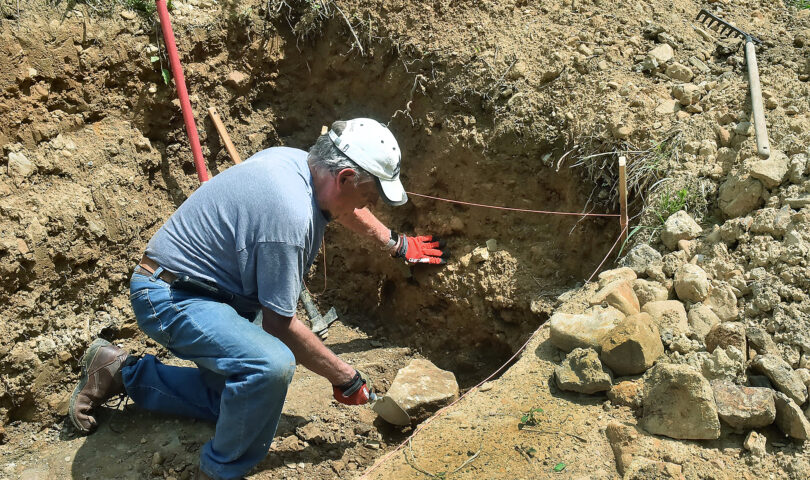At a wooded, rural site near Morgantown on Wednesday afternoon, Michael Kief spent several minutes peering into the abyss.
It was in the form of geometric hole, some 4 feet deep, that the former West Virginia State Police lieutenant hopes will yield some final answers to murder case which has chilled and intrigued the Morgantown community for more than 50 years.
Kief worked on a number of cold cases involving forensic investigation during his career.
He was quickly hired back by State Police as a civilian employee in that discipline following his recent retirement.
Ironically, this opening in the earth he was examining looked like it could have been for a grave.
It could still very well be.
On a cold January evening in 1970, WVU freshmen and friends Karen Ferrell and Mared Malarik were hitching a ride back to their dorm after catching a movie downtown.
Their decomposed, decapitated bodies were discovered four months later by a West Virginia National Guard unit.
State Police, leading the investigation after the friends failed to show in their dorm or for class, was acting in part from a series of anonymous letters.
The letters said this particular area – in the same general expanse where Kief was standing Wednesday – would be the area where the two victims would be found.
A half-century later, their heads have yet to be located.
For the past two weeks, he and his fellow investigators have been meticulously chipping away the soil and rock.
Underneath it all, those investigators now believe, is also where the missing remains might ultimately be found.
Bone fragments. Maybe even (almost) intact skulls – depending upon the whims of a half-century of elements and strata.
The area was extensively renovated in the years after the investigation and initial discovery.
That’s making slow, thoughtful work even more so, as metric tons of fill dirt, rock and sand have been layered unto the mix.
Investigators have uncovered a scrap of cloth in recent days, along with a spent pull-tab from a long-ago beer can.
Broken glass from other beer bottles and two spent, small-caliber bullets, also.
‘Looking at it every way, and any way you can’
Before the earth was even turned, though, cadaver dogs were set loose on the scene.
And six different canines, working separately, each yelped and wagged their tales furiously during their lone work where Kief and crew would soon begin digging.
The man who finally persuaded State Police to take another look was standing next to the forensic investigator this afternoon.
Albert “Rod” Everly, a Morgantown businessman, contractor and former teacher, was in that National Guard unit and was supervising a search team when the discovery was made.
He was second on the scene, in fact.
A former guardsman never forgot what he saw, he said Wednesday. The case has always stayed with him.
The dogs only reaffirmed a tale already told, he said.
Everly calls it, the “overlooked confession,” in a case that didn’t take long to become part of Morgantown lore.
A recent book and podcast has reawakened interest in the case for many, including Everly.
He started doing some of his own research, and contracted the dog teams himself. That’s how State Police became involved.
The lore of the case is populated with anonymous letters, chilling implications of a murderous cult – the Charles Manson-led slashing murders of Hollywood actress Sharon Tate and others had only happened the year before.
Don’t forget a dubious confession that only added to the mystery.
There’s that, and the sad, grisly aside that the heads of the victims have yet to be found.
Everly, as said, has chosen to dig into those letters – with their quadrants, coordinates and geometric, mathematical intricacies.
Back during his days as an instructor of drafting and mechanical drawing at the Monongalia County Technical Education Center, Everly’s students often received state and national accolades for their achievements.
Their teacher did, too.
“It’s about coming up against a challenge, then looking at every way, and any way you can to find a solution,” he said.
He was bolstered by those cadaver dogs, he said, because where they went was where the author of the letters said they should go.
The person who killed the coeds wrote the letters, he said.
“It’s all right there,” he said. “It’s just gonna be a relief if something is finally unearthed after all these years.”
Telling it for the ages
Using garden trowels and working painstakingly by hand, the forensic team is finally digging down to the level of what Everly thinks is the original grade of the earth in 1970, before all the other work was done.
Wednesday, they thought they had a break, in the form of sunken areas of dirt. No answers, though, once the soil was scraped away.
Besides – the final evidence, according to the author of those long-ago letters, could still be about a foot below that.
Which means digging.
And more digging.
Kief echoed Everly on Wednesday as he talked about the potentials and possibilities of the re-visited case.
“Well, it would mean everything in the world if the remains are located,” he said. “I’ve talked about closure before, and that’s what this would be.”
Fifty years is a long time, he said.
Two sets of parents, sand-blasted by grief, spent their remaining days coexisting with a void that was blacker than black.
“We have no way of knowing what fully happened,” the investigator said.
He meant Ferrell and Malarik’s last moments alive.
Were both shot in the head? If there was just one murderer, why didn’t one of them try to run?
“Finding that evidence would let them tell their story.”
TWEET @DominionPostWV




